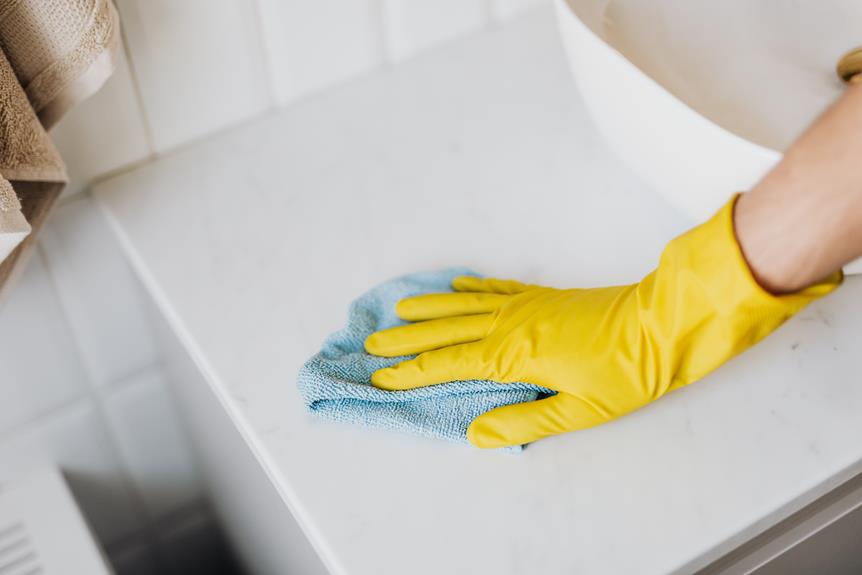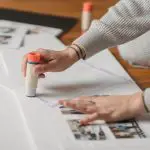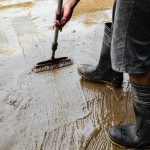If you've ever wondered whether Gorilla Glue can bond rubber fabrics, you're in the right place. This brief guide will provide you with the knowledge and techniques needed to master the art of bonding rubber fabrics with Gorilla Glue.
From understanding the properties of rubber fabrics to learning the best application techniques, we'll cover everything you need to know to achieve strong and durable bonds.
Whether you're working on a DIY project or a professional application, mastering the bonding process will open up a world of possibilities for you.
So, let's dive in and explore the world of bonding rubber fabrics with Gorilla Glue.
Key Takeaways
- Rubber fabrics have unique properties such as elasticity, durability, and resistance to water and chemicals.
- Gorilla Glue is versatile and can bond various materials, including rubber fabrics, with exceptional strength.
- Thoroughly clean the surfaces of rubber fabrics to remove dust, debris, oils, and grease before applying Gorilla Glue.
- Proper surface preparation and selection of a Gorilla Glue product designed for rubber are essential for optimal adhesion and bond strength.
Understanding Rubber Fabrics
Rubber fabrics encompass a wide range of materials used in various applications. These fabrics are known for their unique properties, including elasticity, durability, and resistance to water and chemicals. Fabric properties play a crucial role in determining the suitability of rubber fabrics for specific uses.
For instance, in industrial settings, rubber fabrics with high tensile strength and excellent tear resistance are preferred for conveyor belts and gaskets. Understanding the fabric properties is essential for selecting the right material for a particular application.
Bonding techniques are also a key aspect of working with rubber fabrics. Due to their chemical composition and surface characteristics, not all adhesives are suitable for bonding rubber fabrics. The choice of bonding technique depends on factors such as the type of rubber fabric, the environmental conditions it will be exposed to, and the required bond strength.
Common bonding techniques include vulcanization, adhesive bonding, and heat-activated bonding processes. Each method has its advantages and limitations, and selecting the appropriate bonding technique is crucial for ensuring the integrity and longevity of the bonded rubber fabric.
Understanding the fabric properties and bonding techniques is essential for working with rubber fabrics effectively and achieving optimal performance in various applications.
Properties of Gorilla Glue
What are the specific properties of Gorilla Glue that make it suitable for bonding rubber fabrics effectively?
Gorilla Glue is renowned for its exceptional bonding capabilities, owing to its unique properties. One of its key features is its versatility, as it can bond various materials, including rubber fabrics, with remarkable strength.
The adhesive properties of Gorilla Glue are attributed to its ability to penetrate the fibers of the materials it bonds, creating a powerful and durable bond. Additionally, its resistance to water and extreme temperatures further enhances its suitability for bonding rubber fabrics, making it ideal for both indoor and outdoor applications.
Another remarkable property of Gorilla Glue is its expansion capability, which allows it to fill gaps and irregularities in the surfaces being bonded. This property is particularly advantageous when working with rubber fabrics, as it ensures a comprehensive and uniform bond, even on uneven surfaces.
Furthermore, Gorilla Glue's quick-drying nature and high strength make it an efficient choice for bonding rubber fabrics, providing a reliable and long-lasting bond. Understanding these properties is crucial for mastering the bonding techniques when working with Gorilla Glue and rubber fabrics, as they enable the optimal utilization of this adhesive for various applications.
Surface Preparation for Bonding
To ensure successful bonding with Gorilla Glue, you should thoroughly clean the surfaces of the rubber fabrics and remove any dust or debris. Surface cleaning is crucial for achieving a strong bond. Use a mild detergent and water to clean the surfaces, and then dry them completely. Ensure that the rubber fabrics are free from any oils, grease, or other contaminants that could hinder adhesion.
In some cases, using adhesion promoters or bonding agents can enhance the adhesion of Gorilla Glue to rubber fabrics. These products are specifically designed to improve the bonding capabilities of adhesives on difficult-to-bond surfaces such as rubber. However, it's essential to ensure chemical compatibility between the adhesion promoter or bonding agent and both the rubber fabrics and the Gorilla Glue.
Before applying any adhesion promoters or bonding agents, it's important to carefully read and follow the manufacturer's instructions. Improper use of these products can negatively impact the bonding process.
Application Techniques for Rubber
Now that we've covered surface preparation for bonding, let's move on to the application techniques for rubber.
You'll learn about the different methods for bonding rubber to surfaces and the best adhesive application techniques.
These points will provide you with valuable insights into effectively applying adhesives to rubber fabrics.
Bonding Rubber to Surfaces
How can you effectively bond rubber to surfaces using Gorilla Glue?
- Ensure Surface Compatibility:
- Clean the surface thoroughly to remove any dirt, oil, or debris that could hinder the bonding process.
- Roughen the surface with sandpaper to create a better grip for the adhesive.
- Adhesive Selection:
- Choose a Gorilla Glue product specifically designed for rubber and suitable for the surface material.
- Apply the adhesive evenly and sparingly to avoid excess glue that could seep out and create a messy bond.
- Application Technique:
- Press the rubber firmly onto the surface and use clamps or weights to hold it in place while the glue sets.
Adhesive Application Methods
After preparing the surface and selecting the appropriate adhesive, firmly press the rubber onto the surface and use clamps or weights to hold it in place while the glue sets. When applying adhesive to rubber, it's essential to consider adhesive compatibility and bonding strength. Here are some effective adhesive application methods for rubber:
| Application Method | Description |
|---|---|
| Brushing | Apply adhesive evenly with a brush |
| Spraying | Use a spray gun for uniform coverage |
| Dipping | Submerge rubber into adhesive solution |
| Roll Coating | Use a roller to apply adhesive evenly |
| Heat Activation | Apply adhesive, then use heat to activate bonding |
Bond Strength and Durability
When evaluating the bond strength and durability of Gorilla Glue on rubber fabrics, it's important to consider its compatibility with different types of rubber. Assessing the long-lasting bond and impact resistance will provide insight into the overall performance of the adhesive.
Gorilla Glue Rubber Compatibility
You can test the bond strength and durability of Gorilla Glue when used on rubber fabrics. When evaluating Gorilla Glue rubber compatibility, consider the following:
- Rubber Adhesion:
- Gorilla Glue is designed to bond to a wide range of materials, including rubber. When used correctly, it can form a strong and durable bond with rubber fabrics.
- Proper surface preparation is crucial for achieving optimal adhesion. Ensure the rubber surface is clean, dry, and free from any contaminants that may hinder the bonding process.
- Glue Compatibility:
- Gorilla Glue is known for its versatility and ability to bond various materials. It's important to follow the manufacturer's guidelines and recommendations for the best results when working with rubber fabrics.
Long-Lasting Bond Assessment
Assessing durability is crucial to determine the bonding effectiveness of Gorilla Glue on rubber fabrics. To evaluate bond strength, perform tests such as tensile strength, shear strength, and peel strength to measure the force required to break the bond.
Additionally, consider environmental factors like temperature, moisture, and exposure to chemicals, which can impact the durability of the bond over time. Long-term durability testing involving simulated aging and usage conditions provides valuable insights into the effectiveness of the bond.
Impact Resistance Evaluation
To evaluate impact resistance and ensure the long-lasting bond strength and durability of Gorilla Glue on rubber fabrics, it's important to conduct rigorous tests simulating real-life usage conditions.
- Impact resistance testing: This involves subjecting the bonded rubber fabrics to controlled impact forces to assess the ability of Gorilla Glue to maintain its adhesive strength and bonding flexibility under stress.
- Material compatibility: Understanding how Gorilla Glue interacts with different rubber fabrics is crucial for predicting its performance in diverse applications.
- Bond strength and durability assessment: Assessing the long-term durability of the bond under various environmental conditions such as temperature changes, moisture exposure, and mechanical stress is essential for determining the overall effectiveness of Gorilla Glue on rubber fabrics.
Potential Challenges and Solutions
Bonding rubber fabrics with Gorilla Glue may present challenges such as adhesion durability and flexibility, but solutions can be found through proper surface preparation and adhesive application techniques. When attempting to bond rubber fabrics, it's crucial to consider the compatibility of materials and the specific bonding techniques to ensure the durability of the adhesive joint. Gorilla Glue, known for its strength and versatility, can effectively bond rubber fabrics if the following challenges are addressed:
| Potential Challenges | Solutions |
|---|---|
| Adhesion Durability | Use a primer or adhesion promoter to enhance the bond strength of Gorilla Glue on rubber fabrics. Ensure that the surfaces are clean and free of any contaminants that may compromise adhesion. |
| Flexibility | Choose a Gorilla Glue formula specifically designed for flexibility, such as Gorilla Super Glue or Gorilla Clear Glue. These formulas provide strong and flexible bonds suitable for rubber fabrics. |
| Curing Time | Control the curing time by adjusting the amount of adhesive applied and providing the appropriate clamping pressure to ensure a consistent and durable bond. |
| Temperature Resistance | Select a Gorilla Glue product with high-temperature resistance to ensure the bond remains strong under varying environmental conditions. |
Best Practices for Successful Bonding
When bonding rubber fabrics with Gorilla Glue, ensure that the surfaces are thoroughly cleaned and free of contaminants to promote strong adhesion. Material compatibility is crucial for successful bonding. Follow these best practices to achieve optimal results:
- Surface Preparation: Clean the rubber fabrics with a mild detergent to remove any dirt, oil, or dust. Rinse thoroughly and allow the surfaces to dry completely before applying the adhesive.
- Adhesive Selection: Choose the appropriate Gorilla Glue formula that's designed for bonding rubber materials. Consider factors such as flexibility, temperature resistance, and curing time to select the most suitable adhesive for your specific application.
- Application Technique: Apply the Gorilla Glue evenly to one surface using a thin layer. Press the surfaces together firmly to ensure maximum contact and eliminate air pockets. Use clamps or weights to hold the bonded pieces in place while the adhesive cures.
Frequently Asked Questions
Can Gorilla Glue Be Used to Bond Rubber Fabrics to Non-Rubber Materials?
Yes, Gorilla Glue can bond rubber fabrics to non-rubber materials. It offers strong bonding techniques for various materials. However, if you need adhesive alternatives, consider specific rubber adhesives for a more tailored solution.
Are There Any Specific Types of Rubber Fabrics That Gorilla Glue May Not Bond Effectively?
Some types of rubber fabrics, like silicone and fluorosilicone, may pose bonding challenges with Gorilla Glue. These materials have low surface energy, making it difficult for adhesives to form a strong bond.
Can Gorilla Glue Be Used for Outdoor Applications With Rubber Fabrics?
For outdoor applications with rubber fabrics, Gorilla Glue alternatives may be more suitable. Best practices for bonding rubber fabrics include using adhesives specifically designed for outdoor use, ensuring proper surface preparation, and following manufacturer's instructions closely.
Is There a Recommended Temperature Range for Using Gorilla Glue to Bond Rubber Fabrics?
For bonding rubber fabrics using Gorilla Glue, ensure the recommended temperature range is 50-120°F for optimal bonding strength. This adhesive offers excellent outdoor durability due to its superior adhesive properties, making it ideal for various outdoor applications.
What Are the Potential Long-Term Effects of Using Gorilla Glue to Bond Rubber Fabrics, Such as Exposure to Water or UV Rays?
Exposing rubber fabrics bonded with Gorilla Glue to water or UV rays can pose potential risks, affecting their durability and flexibility. Consider the environmental impact and long-term effects of these factors when using the adhesive.
- Can You Get Organza Wet? - April 23, 2024
- Why Is Organza so Popular? - April 23, 2024
- What Do You Wear With Organza? - April 23, 2024








